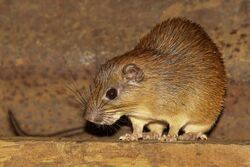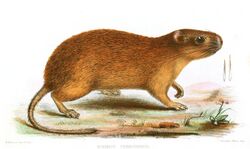Biology:Mesomys
| Mesomys | |
|---|---|

| |
| Ferreira's spiny tree-rat | |
| Scientific classification | |
| Domain: | Eukaryota |
| Kingdom: | Animalia |
| Phylum: | Chordata |
| Class: | Mammalia |
| Order: | Rodentia |
| Family: | Echimyidae |
| Subfamily: | Echimyinae |
| Tribe: | Echimyini |
| Genus: | Mesomys Wagner, 1845 |
| Type species | |
| Mesomys ecaudatus | |
| Species | |
|
Mesomys hispidus | |

Mesomys is a genus of South American spiny rats in the family Echimyidae.[1]
The genus name Mesomys derives from the two ancient greek words μέσος (mésos), meaning "middle of, between", and μῦς (mûs), meaning "mouse, rat".[2][3] It refers to the fact that these rodents — literally the "middle mouse" — were considered an intermediate form between the genus Loncheres and the genus Echinomys, both of which are now known to be synonyms of Echimys.[4][5]
Extant Species
| Image | Scientific name | Common Name | Distribution |
|---|---|---|---|
| Mesomys hispidus | Ferreira's spiny tree-rat | Bolivia, Brazil, Colombia, Ecuador, French Guiana, Guyana, Peru, Suriname and Venezuela | |
| Mesomys leniceps | Woolly-headed spiny tree-rat | Peru | |
| Mesomys occultus | Tufted-tailed spiny tree-rat | Brazil | |
| Mesomys stimulax | Pará spiny tree-rat | Brazil. |
Phylogeny
Mesomys is a member of the Echimyini clade of arboreal Echimyidae rodents.[6] The closest relative of Mesomys is Lonchothrix, reflecting the fact that these taxa have once been classified in the Eumysopinae,[1] a subfamily now recognized as an artificial assemblage.[7] These two genera share phylogenetic affinities with several taxa and clades: (i) Echimys, Phyllomys, Makalata, Pattonomys, and Toromys ; (ii) the bamboo rats Dactylomys, Olallamys, Kannabateomys together with Diplomys and Santamartamys ; and (iii) Isothrix.[8]
| Genus-level cladogram of the Echimyini. |
References
- ↑ 1.0 1.1 Woods, C.A.; Kilpatrick, C.W. (2005). "Genus Mesomys". in Wilson, D.E.; Reeder, D.M. Mammal Species of the World: A Taxonomic and Geographic Reference (3rd ed.). Johns Hopkins University Press. pp. 1583–1584. ISBN 978-0-8018-8221-0. OCLC 62265494. http://www.departments.bucknell.edu/biology/resources/msw3/browse.asp?id=13400472.
- ↑ Bailly, Anatole (1981-01-01). Abrégé du dictionnaire grec français. Paris: Hachette. ISBN 978-2010035289. OCLC 461974285.
- ↑ Bailly, Anatole. "Greek-french dictionary online". http://www.tabularium.be/bailly/.
- ↑ Wagner, Johann Andreas (1845). "Diagnosen einiger neuen Arten von Nagern und Handflüglern". Archiv für Naturgeschichte 11 (1): 145. https://www.biodiversitylibrary.org/item/30279#page/153/mode/1up.
- ↑ Palmer, T. S. (1904) (in en). Details - Index generum mammalium: a list of the genera and families of mammals. - Biodiversity Heritage Library. Washington, Govt. Print. Off.. pp. 415. doi:10.5962/bhl.title.39809. https://archive.org/details/indexgenerummamm23palm/page/n422/mode/1up.
- ↑ Fabre, Pierre-Henri; Patton, James L.; Leite, Yuri L. R. (2016). "Family Echimyidae (hutias, South American spiny-rats and coypu)". Handbook of the Mammals of the World. Vol 6. Lagomorphs and Rodents I. Barcelona: Lynx Edicions. pp. 552–641. ISBN 978-84-941892-3-4.
- ↑ Fabre, Pierre-Henri; Galewski, Thomas; Tilak, Marie-ka; Douzery, Emmanuel J. P. (2013-03-01). "Diversification of South American spiny rats (Echimyidae): a multigene phylogenetic approach" (in en). Zoologica Scripta 42 (2): 117–134. doi:10.1111/j.1463-6409.2012.00572.x. ISSN 1463-6409.
- ↑ Fabre, Pierre-Henri; Upham, Nathan S.; Emmons, Louise H.; Justy, Fabienne; Leite, Yuri L. R.; Loss, Ana Carolina; Orlando, Ludovic; Tilak, Marie-Ka et al. (2017-03-01). "Mitogenomic Phylogeny, Diversification, and Biogeography of South American Spiny Rats". Molecular Biology and Evolution 34 (3): 613–633. doi:10.1093/molbev/msw261. ISSN 0737-4038. PMID 28025278.
Wikidata ☰ Q911378 entry
 |

